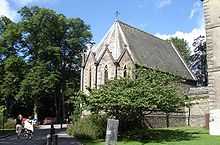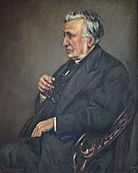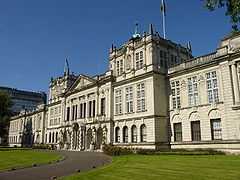The Cathedral School, Llandaff
 | |
| Established |
c.9th Century 1880 (current school) |
|---|---|
| Type |
Independent school Choral foundation school |
| Religion | Anglican |
| Headmaster | Mr Stephen W Morris |
| Head Girl | Nicole Singh-Clark |
| Custos (Chairman) | Mr Gilbert Lloyd |
| Founder | Dean John Vaughan & Canon Nathaniel Woodard |
| Location |
Cardiff Road Cardiff CF5 2YH Wales |
| Local authority | Cardiff City Council |
| DfE URN | 402015 Tables |
| Students | 700 |
| Gender | Coeducational |
| Ages | 3–18 |
| Colours |
Black, Maroon and Gold |
| Former pupils | Old Llandavians |
| Website |
www |
The Cathedral School, Llandaff is a coeducational independent day school located in Llandaff, a district north of the Welsh capital Cardiff. Originally established as a choral foundation to train choir boys for the affiliated Llandaff Cathedral, it is now part of the Woodard Schools foundation and continues to provide choristers for the cathedral. It is the only surviving Anglican choir school in Wales and is a member of the ISC, IAPS and the Choir Schools Association.[1]
History

The school survived an impoverished time during 1691, when it was called the Free School, and was housed in the Chapter House. Between 1744 and 1746, the present school, designed by John Wood of Bath, was built on the site of Bryn-y-Gynnen. It was known originally as Llandaff Court and was owned by Thomas Mathews. Admiral Matthews heartily disliked the building, comparing it to a "3 Decker" ship. It is nonetheless considered "the most complete and well-proportioned eighteenth-century building in the Cardiff area", buildings of that period being a rarity in the city.[2] In 1840 the office of Dean was revived and the Cathedral was restored by John Prichard. The present school chapel was designed by Ewan Christian in 1858–9.[3]
An article in The Guardian in 1871, which carried an account of the start of a boarding school for choristers in Salisbury, gave the Reverend Fishbourne the idea for a similar establishment in Llandaff for some 20 boys—all potential choristers. The School was housed in a small house near Llandaff Bridge. Soon after, the Chapter cut down Fishbourne's original scheme—much to his disappointment.
In 1879, when Dr. Vaughan became Dean, he began plans for a school (now demolished) for around 50 boys at The Cathedral Green in Llandaff village and this was opened in 1880. Dean Vaughan had been headmaster at Harrow School and was a great scholar; the school was opened in the village in 1880 and remained on that site until 1958. Dean Vaughan died in 1897 leaving the school with firm foundations.
A German landmine severely damaged the nave of the cathedral in 1941 and, when restoration work was completed in 1955, the old school building was found to be "unsuitable", causing it to be moved to the present premises three years later, which had until then been used as the Bishop's Palace. The school then became a member of the Nathaniel Woodard Corporation.
While Roald Dahl was a pupil at the school, he was involved in the "Great Mouse Plot of 1924", which he later described in his autobiography, Boy: Tales of Childhood. This is the first of numerous occasions in which he outlines in great detail the perceived cruelty of corporal punishment in schools. The headmaster at this time was Mr T R Coombes.
In 1961, the Cathedral School became a member of the Woodard Schools, a family of Anglican schools in England and Wales. Girls were first admitted in 1978 and now make up over one-third of the student population. In 2001 the senior school was opened to children aged 11 to 16. A sixth form was opened in September 2013.[4]
Structure
The Cathedral School consists of three sections: Infant School (ages 3–7), Junior School (ages 7–11) and Senior School (Years 7-13). Sixth form teaching began in September 2013. In the 2012 Estyn inspection, the overarching judgements made by the inspectors were that the school's current performance was Excellent and that the school's prospects for improvement were Excellent.
Curriculum
Junior School
Modern Language education begins early, generally during Key Stage 2. In the 2005 inspection, pupils were reported to have performed well above the national average in National Curriculum tests.
Senior School
A traditional academic education, with sciences separately taught by specialists, along with a range of modern languages (French, Spanish, German) in addition to Latin, is delivered alongside very competitive sport (senior pupils have an unusually generous amount of time allocated to sport) and opportunities in the Arts. Pupils have generally performed well in the GCSE exams. The school was ranked top co-educational school in Wales in 2012 for GCSE success (The Times, 1st September 2012) Every pupil up to Year 9 receives music tuition for 45 minutes per week in class, as well as the opportunity to participate in one or more of the many orchestral or choral groups maintained by the staff of 20 visiting music teachers. Interested pupils may choose to take GCSE music.
Pastoral Care
Every pupil in the Senior Section is a member of one of three senior Houses, named after the Llandaff saints: Dyfrig, Euddogwy and Teilo. The pupils are cared for by one of five House Tutors, who in turn are overseen by a Housemaster/mistress. Housemasters, assisted by their tutor teams, are responsible for pupils' pastoral care, oversight of their academic progress and personal development. Pupils exercise their leadership skills within the House context, growing in confidence and ability to relate to others, and to lead and manage people and events.[5]
Activities
Music
Both boy choristers and choral scholars have done work in the Wales Millennium Centre, with Welsh National Opera, Bryn Terfel and Carlo Rizzi, respectively. Music in general at the Cathedral School is very strong with numerous pupils at Grade 8 standard. The music department is housed in the Jubilee building, with a full range of instruments at one's disposal. There are also specialist teachers in 20 different instruments. There are numerous school groups as well, from School Orchestra to Swing Band, from Flute Group to Senior Chamber Choir. Most recently, the school hosted its St Cecilia's Day Concert at the Wales Millennium Centre, showcasing the broad spectrum of the school's finest choirs and instrumental ensembles, culminating in an impressive performance of Fauré’s Requiem.
Drama
Drama has thrived only recently in the Cathedral School but is rapidly expanding. Recent performances include abridged versions of Macbeth and Blood Brothers, as well as HMS Pinafore, A Christmas Carol and Wind in the Willows. Pupils have begun writing their own work for 'gala evenings' and many pupils are on the books of National Youth Theatre.
Sport
There are over twenty different sports played at the Cathedral School, with pupils at international level in cricket, badminton and rugby, gymnastics and sailing. . . Senior School pupils are encouraged to be active in sports teams. Unusual for a choral foundation school, the Cathedral also offers scholarships based on athletic ability.
Notable Old Llandavians
Former students of The Cathedral School, Llandaff are referred to as Old Llandavians.
- Roald Dahl, Author
- Robin Sowden-Taylor, Wales international rugby player
- Simon Hughes, MP
- David Rowe-Beddoe, Baron Rowe-Beddoe, Chairman of the Wales Millennium Centre
- T. C. Worsley, Theatre & television critic
- Basil John Douglas Guy, (Victoria Cross, Distinguished Service Order)
- David Mahoney, Member of Only Men Aloud[6]
- David Bevan, Sang in the choir at Westminster Abbey for the Queen's Coronation (1953) - received Coronation Medal for 'Personal Service to the Sovereign" - Dean's Scholar and Captain of Rugby in 1954)
- Donald Box, MP
- David Howard-Jones, businessman and Board director - Dean's Scholar 1985 & 86
- Charlotte Church, singer and TV personality
- John Morgan (bishop)
- John Robins (Cardiff and Wales rugby)
- Richard William Leslie Wain, Victoria Cross
- Edward William Williamson, Bishop
- Rex Willis, Welsh Rugby player
- Peter Wingfield, actor
Headmasters
- The Revd C.E. Butler (1880–1883)
- The Revd E. Owen (1883–1889)
- The Revd J.E. Stevenson-More (1889–1905)
- The Revd P.R. Cleave (1905–1912)
- G.L. Robanthan & R. Brice-Smith (1912–1919)
- T.R. Coombes (1919–1946)
- N.L. Westbury-Jones (1946–1957)
- R.J.B. Hulland (1957–1975)
- G.L. Hill (1975–1983)
- J.C. Knapp (1983–1993)
- D.A. Evans (Acting Head) (1993–1994)
- P.L. Gray (1994–2008)
- S. Morris (2008– )
Head Boys and Head Girls
Since the building of the school sixth form
- Jake Maddocks and Nicole Singh-Clark (2014–2015)
Previously:
- Mannat Chopra and Emily Liepa (2012-2013)
- Robert Lindsay and Angharad Clemens (2011-2012)
- James Groves and Rose Stevens (2010-2011)
- Matthew Chapman and Holly Lidbury (2009-2010)
- William Searle and Rhiannon Hickinbottom (2008-2009)
- Piers Kennedy and Phillipa Donavan (2007-2008)
References
- ↑ http://www.choirschools.org.uk/
- ↑ Hilling, John B. (1973). Cardiff and the Valleys: Architecture and Townscape. London: Lund Humphries. p. 27.
- ↑ Newman, John. Glamorgan. The Buildings of Wales. London: Penguin Books. p. 259.
- ↑ Sixth Form
- ↑ Senior School - Pastoral Care
- ↑ "Only Men Aloud member judge Cathedral School musical talent". South Wales Echo. 8 November 2010.
External links
| Wikimedia Commons has media related to The Cathedral School, Llandaff. |
- The Cathedral School website
- Profile on Independent Schools Council website
- 2005 Estyn Inspection Report
| ||||||||||||||||||||

